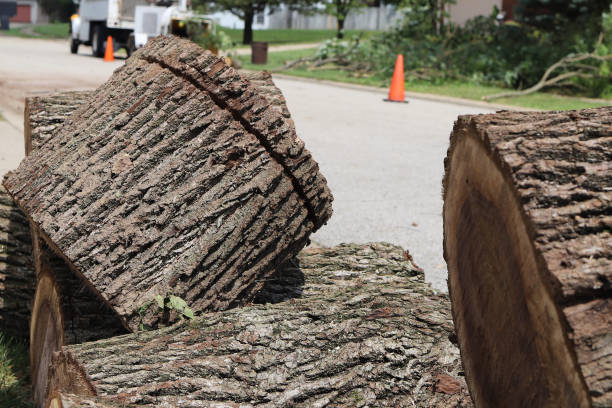Assessing the damage around your property after a storm or accident is crucial. Check for downed power lines and any structural risks nearby.
You might think about moving debris, but hold off until you’re sure it’s safe.
Documenting everything can be essential for insurance claims.
As you navigate this situation, consider what steps to take next and how to prevent future incidents that could put your property at risk.
Assessing the Damage and Safety Risks
When a tree falls or appears unstable, swift assessment is crucial to ensure safety and minimize damage.
Immediate Safety Precautions
- Check for Power Lines: Keep your distance and contact emergency services if wires are down.
- Inspect Structural Damage: Examine your home, roof, or nearby buildings for impact.
- Identify Unstable Branches: Look for loose limbs or leaning trunks that pose a further risk.
Next Steps for Safety and Documentation
- Secure the Area: Protect children, pets, and passersby from potential hazards.
- Document the Damage: Take clear photos for insurance claims.
- Consult Professionals: Contact a certified arborist or tree removal service for safe cleanup.
Acting quickly and carefully can prevent injuries, reduce costs, and protect your property.
Contacting Professionals for Tree Removal
Once you’ve assessed the damage and ensured safety, it’s essential to contact qualified professionals for safe and efficient tree removal.
Finding the Right Experts
- Check Credentials: Look for certified arborists or insured tree removal companies.
- Read Reviews: Prioritize services with positive feedback and emergency experience.
- Confirm Equipment Use: Ensure they have the proper tools to handle complex removals.
Communicating Key Details
- Describe the Situation: Mention the tree’s size, location, and nearby hazards.
- Request Estimates: Ask for quotes and expected timelines before proceeding.
- Act Quickly: Prompt removal helps prevent additional property damage or safety risks.
Choosing experienced professionals ensures the job is done safely and effectively, giving you peace of mind.
Preventing Future Incidents and Preparing for Storms
Taking proactive steps can help protect your property from tree-related storm damage.
Tree Maintenance and Inspection
- Assess Regularly: Check for cracks, dead branches, or leaning trunks.
- Consult Professionals: An arborist can advise if pruning or removal is necessary.
- Trim Overhanging Limbs: Reducing branch weight minimizes breakage risks.
Planting and Landscape Planning
- Choose Resilient Species: Select trees known to withstand your local climate.
- Maintain Safe Distances: Plant trees away from power lines, roofs, and windows.
- Use Strong Root Systems: Opt for trees with deep roots to improve stability.
Storm Preparation Tips
- Create an Emergency Plan: Know how to secure outdoor items and clear debris.
- Stay Informed: Monitor weather alerts to prepare before storms arrive.
By staying proactive, you can reduce risks and keep your property safe during extreme weather.
Dealing with tree damage after a storm can be stressful, but taking the proper steps can protect your property and prevent future issues.
By assessing risks, contacting qualified professionals, and investing in regular tree maintenance, you can ensure your home’s safety and security.
Proactive care minimizes storm-related damage and helps maintain a healthy, thriving landscape for years to come.

